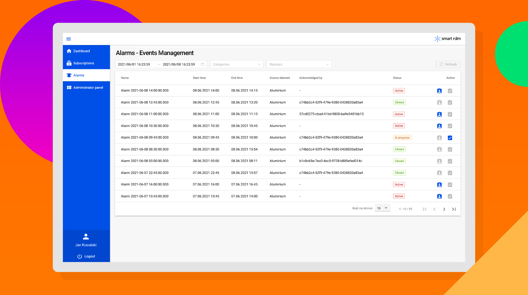Are you ready for real-time data?
Digital transformation, Industry 4.0, digitalisation are some of the many buzzwords that have been accompanying entrepreneurs for some time now.
Regardless of the industry in which an organisation operates, its owners are increasingly investing in different types of systems and solutions, looking for innovation and optimisation. These investments aim to increase a company's profitability, adapt to market requirements (both business and regulatory) and increase customer satisfaction. Additional elements that have gained in importance are environmental issues. CO2 reduction, energy efficiency are some of the main challenges facing companies in the industrial, energy, heating, or water and sewage sectors.
Many systems and large amounts of data
The company is armed with many specialised solutions, ERP, CRM, SCADA, MES...and other specialised products. The amount of data and its sources is growing at an astronomical rate.
Here, the critical question arises. Can businesses effectively deal with the data they collect?
A good example is a large heating company dealing with a procedure to sign a contract and launch a service to a new customer. When a customer signs a contract, their data is entered into the billing system along with the parameters specified in the contract. The next step is to manually transcribe this data into the order system and GIS system. So adding a new customer requires a manual data entry in at least three systems. And that's not all. Once the meter has been installed at the customer's premises, this again has to be confirmed manually. The billing system downloads meter data once a month, which means that if the installation took place between billing periods, there is no data in the system for x days. In addition, several different IDs appear throughout the process, which characterises the customer/meter/order differently depending on the system.

We can also illustrate the described problem with the production reporting process in an energy company. Once a month, the analysis department sends a request to all facilities for production data. After receiving the feedback, it prepares a report on the total production in the company and "keeps its fingers crossed" that no branch changes anything in its "Excel". Otherwise, the result will have to be consolidated again.
Another challenge for companies is the preparation of the aforementioned environmental reports related to the implementation of CO2 reduction targets and climate neutrality. In the case of our energy company, data is downloaded from the SCADA system, then entered into the report, and analysed manually. In the following month, further data must be filled and manually verified. An analytical team must also check the consistency of this data with the previous month's report.
The above examples show how the processes look if they are not monitored in real-time and without a system that can correctly aggregate and interpret data from other solutions.
The same processes look entirely different after the implementation of appropriate tools. In the case of a heating company, data are entered into the billing system after signing a contract. A universal ID is automatically assigned. This starts a process in which ID is broken down into appropriate codifications via the databus, the installation order is automatically generated, and the location in the GIS is added. When the meter is installed, the download of real-time data to the billing system automatically starts.
In the energy company, the system collects data in real-time from all branches and distributes reports to designated persons.
The process of generating the environmental report is automated. The tool collects and retrieves information from the SCADA system, validates the data, and compares it with the previous outcome. The result is a ready-to-share environmental report.
How do you achieve this and even better results? You need a well-planned process and tools.
Handling data, both historical and real-time, brings specific challenges. Their optimal use often causes us to face various dilemmas: Is the organisation ready to work with many different solutions? Can we be sure that the investment will pay off? Will we be able to use the full potential of the current solutions in combination with the new system?
It is essential to take the right approach and consider how we can make good use of what is already present in the organisation's infrastructure. In ConnectPoint, this aspect is crucial for us – how we can optimally use the resources and prepare the company for the introduction of new solutions. We work step by step, collecting data from many systems within one platform - Smart RDM.
Smart RDM platform
Aggregating data from business and manufacturing systems and accurately determining operating costs allows us to apply proven industry algorithms to turn this data into actionable information. We start with historical records and feed them to Smart RDM. This data forms the basis for running specialised validation algorithms and is the foundation for the following steps. You can read more about the data validation process here.
.png?width=528&name=CP%20Blog%20Dane%20w%20Czasie%20Rzeczywistym%20Ilu%2003%20EN%20(1).png)
In this way, we create a central repository that will provide a reliable source of validated data. After all, records have been organised and a CRD (central data repository) has been created, we can proceed to the next steps.
At this stage, the first benefit for the company appears - access to structured data in one place. Why is this benefit? We have a ready-made database for the automatic distribution of reports to each level of the organisation, from the machine operator to the president and external institutions. We can conduct analyses and draw accurate conclusions by linking data from different areas of the organisation. We obtain both a holistic view of the company from the level of the management and a very detailed one, e.g. from the level of a single machine operator. All information is made available and distributed according to an established hierarchy of company roles within one web application, available also from mobile devices.
By building an enterprise data history and analysing it, we are ready to work with data in real-time. Why is historical data so important? After all, we could work with current data and not worry about what came before.
Displaying data in real-time will work, but it will simply be displaying data. The system will learn as it goes along, but you won't be able to take full advantage of analytics and algorithms without history. We want the system to bring tangible benefits to the customer as quickly as possible. The way to do that is to build CRD based on the most accurate historical data possible, which SCADA systems do not offer us.
Another element of the process is to implement real-time data handling, proper, industry-specific reporting and ensuring the quality of information distributed within the company. At ConnectPoint, we know how to do it right. We identify critical systems that require real-time support. Not every system should feed the CRD with data continuously.
We specialise in specific industries to fully build and utilise our domain-specific experience. We know how to configure the handling of this data so that it is optimal and does not cause a problematic growth of the databases. We adapt the algorithms and introduce real-time information distribution processes, such as failure handling. We applied this to a project at the Twinings factory.

"What has been most significant is the shift from post-factum analysis and reactive action to online process monitoring and proactive action in the here and now. We were also able to automate some of the production reports, which reduced the time spent preparing and analysing them. The data needed to be available online." – Marcin Gad, Operations Director at the Polish Twinings factory.
Skilful handling of real-time data will enable us to react quickly to key performance indicators changes and support the optimisation of operations. ConnectPoint Subject Matter Experts will advise you which key parameters monitor, what reports automate and what industry best practices will work in your organisation.
Thanks to the described process and Smart RDM tool, management will gain control over their existing data and will be able to use its potential for business development fully. The described process prepares the organisation for the next stages of digitisation.
This is just the beginning of the road to operational excellence. The next stage is predictive algorithms, which will not only allow rapid responses to changes but will enable the prevention of unwanted events and detailed planning in advance... That's a topic for another article.
Would you like to find out more about Smart RDM? Please visit our website.
Poland Office
ConnectPoint Sp. z o.o.
ul. Zagadki 21
02-227 Warsaw
Poland
German Office
ConnectPoint GmbH
Oberbilker Allee 165
40227 Düsseldorf
Germany
Polnisches Büro
ConnectPoint Sp. z o.o.
ul. Zagadki 21
02-227 Warsaw
Polen
Deutsches Büro
ConnectPoint GmbH
Oberbilker Allee 165
40227 Düsseldorf
Deutschland
Polskie Biuro
ConnectPoint Sp. z o.o.
ul. Zagadki 21
02-227 Warsaw
Polska
Niemieckie Biuro
ConnectPoint GmbH
Oberbilker Allee 165
40227 Düsseldorf
Niemcy
